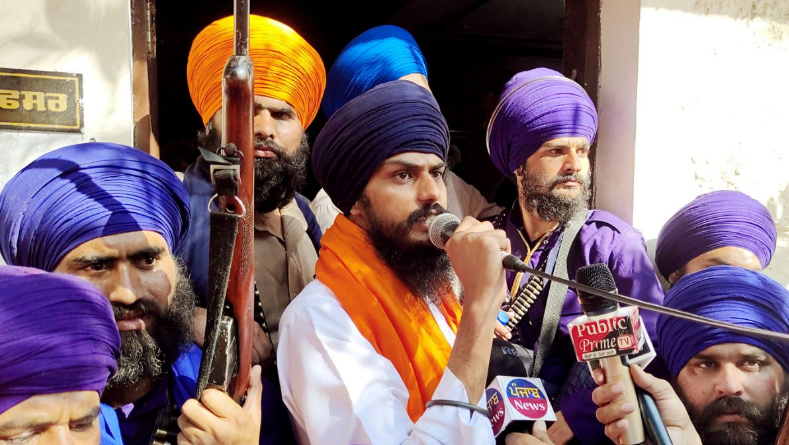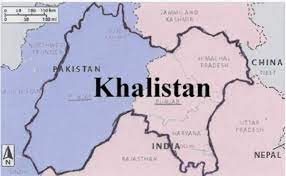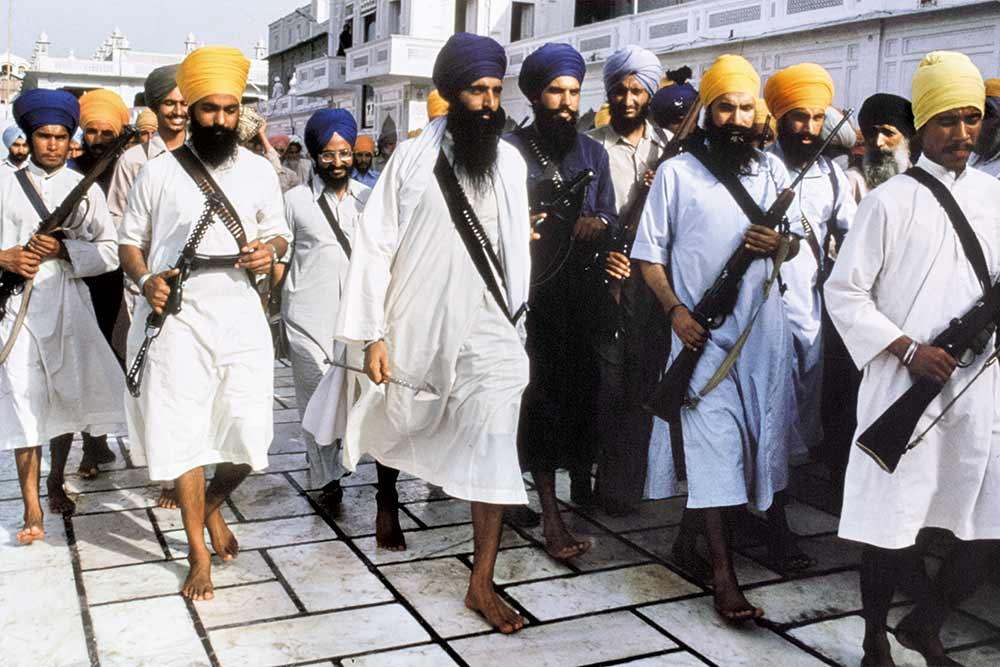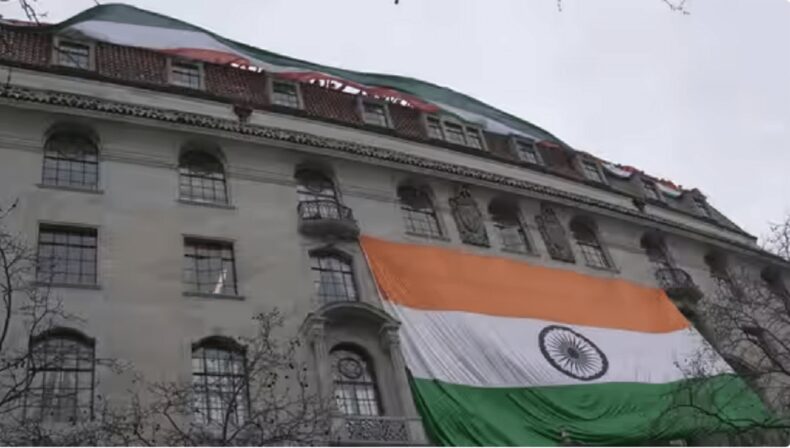The recent protests in Punjab relating to the arrest warrant of the fugitive Amrit Pal Singh are high which shows what deep impacts the so-called leader has made on the youth and the common public to use them as a tool for his propaganda.

Amrit Pal Singh, the chief of the Waris-Punjab-De organization and a follower of the militant Jarnail Singh Bhindranwale who started the Khalistan Separatist Movement in Punjab in 1984 is still absconding when the Punjab and Haryana High Court issued an arrest warrant against him and his supporters. More than 110 of his supporters and sympathizers have been arrested by the Punjab Police, his sudden rise was made when 6 months ago when he was made the chief of the organization and under formal Sikh baptism at Anandpur Sahib at Rode village, the birthplace of Bhindranwale, he echoed his hardlines views and openly called for a separate Sikh state. Having vandalized multiple Gurudwaras and police stations the FIR was lodged which resulted in his arrest orders.
What’s the Khalistan Movement?

The Movement is a fight for a separate, sovereign Sikh state in the present-day Punjab of both India and Pakistan but due to the funding of ISI and western agencies, the conflict is going in the Indian part only. Over the years it has survived in various forms, various places, and different populations. The Movement was crushed by the Government of India during Operation Blue Star (1984) and Operation Black Thunder (1986 and 1988), but due to the economic and mental reinforcement from its sympathizers, foreign funding, and the few Sikh diaspora in the countries such as Canada, the UK, and Australia it continues to operate till date.
2.Starting of the Movement
During the Independence of India in 1947 the larger Punjab was divided into the present day India and Pakistan, the partition saw some of the worst communal violence and resulted in millions of refugees. The Hindus and Sikhs on the west rushed for India and the Muslims in the east fled towards the west resulting in deaths and bloodshed.
The holy places for Sikhs such as Lahore i.e. the capital of the great Maharaja Ranjit Singh, and Nankana Sahib i.e. the birthplace of Guru Nanak ( the founder of Sikhism) remained in Pakistan, the Sikhs who came to India were the 2% of the then population and were given a minority status, since then the political struggle for the greater autonomy of Punjabi Suba Movement or the creation of a Punjabi-speaking state was started by Master Tara Singh, a Sikh leader and a champion of Sikh rights against the dominant Hindus, Muslims, and British during that time. The state reorganization committee in 1966 created Punjab (a state which comprised a majority of Punjabi-speaking and Sikh-majority population) from the trifurcation of Himachal Pradesh and Haryana giving the Hindi-speaking population in these two states.
Anandpur Sahib Resolution
The galvanization of Akali Dal and the Punjabi Suba movement became a major force in the Sikh-majority Punjab and which resulted in the defeat of Congress in the 1967 and 1969 State Legislative Assembly elections. But in 1971 when Indira Gandhi won the election the performance of the Akali Dal’s soon started to underwhelm 1972 after which the party met in 1973 in Anandpur Sahib (a sacred town and the birthplace of the Khalsa) and released a list of demands that would guide the political path of the Akali Dal party. The resolution demanded autonomy for the state of Punjab, identified regions for a separate state, and created its internal constitution.
The demands started reaching to the other parts of the world by 1971 when an advertisement was seen in The New York Times signifying the birth of Khalistan but the Akalis repeatedly interpreted that they do not want secession from India and for the government of India Anandpur Sahib Resolution became a matter of grave concern.
Who was Jarnail Singh Bhindranwale?

Few people thought to go beyond the demand for greater Autonomy in Punjab and one such person was Jarnail Singh Bhindranwale, a preacher who soon positioned himself as “the voice of the Sikhs”. Some sources claim that Bhindranwale was propped up by Sanjay Gandhi, Indira’s son, to stand against the Akalis and the demanding groups to destabilize the government in Punjab for Congress’s political benefit. By the 1980s, the following of Bhindranwale had increased so much that he started to become a problem for the Central government. He radicalized the state’s youth, especially those who were on the lower rungs of the social ladder, and gathered a huge following. He and his followers were becoming more violent.
In the summer of 1982, Bhindranwale, with the support from the Akali Dal Party’s leadership, started an anti-government movement called the Dharam Yudh Morcha and took up residence inside the Golden Temple, directed the demonstrations, and clashed with the police. The movement was started from the very first demands made in the Anandpur Sahib Resolution but due to the growing radicalization in religion, violence in various sections of religion, and Bhindranwale’s harsh rhetoric against Hindus, Indira Gandhi’s government declared the movement tantamount to secession.
Operation Blue Star

By 1984 the authority of Bhindranwale was so immense that the prominent politicians of that time were merely his puppets and the whole law and order of the state was under his indirect commands. At that time Bhindranwale had given a call to arms and instances of violence against Hindus as well as government officers. In 1983, Deputy IG of Punjab Police, AS Atwal was shot dead as he was leaving the Golden Temple after his prayers, and his body was left to decay in the sun while the local police station did nothing – perhaps both out of fear and sympathy to Bhindranwale’s cause.
Indira Gandhi’s government decided to order the Indian Army to march in and flush out militants from the Golden Temple and neutralize Bhindranwale. Operation Blue Star began on June 1, 1984, but due to fierce resistance from Bhindranwale and his heavily armed supporters, as his men were supervised by Major General Shubeg Singh whom himself participated in the 1971 war, the Army’s operation became larger and more violent than had been estimated, with the use of tanks and air support.
The image of Indian Army tanks shelling the holiest shrine of Sikhism was traumatic, as a very large number of civilian casualties happened. As per the government’s report 83 Indian Army soldiers were killed in action and 249 were injured but on the other end 493 militants and civilians were killed in the operation, the other estimates of casualties are much higher than 3000.
What happened after Operation Blue Star?
While the OBS was successful in its aims, Bhindranwale was killed and the Golden Temple was freed of militants but it gravely wounded the Sikh community around the world and It also spurred the demand for Khalistan. On October 31, 1984, Prime Minister Indira Gandhi was assassinated by her two Sikh bodyguards and this triggered the worst communal violence since Partition, even according to conservative estimates, over 8,000 Sikhs were massacred in the infamous Anti-Sikh riots. A year later, sympathizers of Khalistan based in Canada blew up an Air India flight killing 329 people they claimed that the attack was to “avenge Bhindranwale’s death”. It took a long time for Punjab to come out of the causes of militancy. While the movement was allegedly supported by Pakistan to cause internal unrest in India. The bulk of the population turned against the militants, and India headed towards economic liberalization.
Current Status of Khalistan

Punjab has long been peaceful, but the movement lives among some separatist sympathizers overseas. The deep-rooted anger over Operation Blue Star and the desecration of the Golden Temple continues to resonate with some in the radicalized and misguided newer generations of Sikhs. However, as there lives this warrior community who has shed its blood for mother India, given so many national icons, promoted peace in the name of religion, helped the disabled and poor people, brought medals to India’s tally, cultivated wheat, millets, and other grains for the citizens of India, and have been helping the nation in achieving its Golden Age, the issue of Khalistan will remain a dream for its sympathizers.
The recent protests in the UK and the Australia has alarmed the situation for the law enforcing agencies in India, the protest in London near the Indian Embassy and the disrespect of Indian Flag resulted in a decision in removing the barricades from the Embassy and resident of the British High Commissioner in New Delhi showing the world the strength of India’s Foreign Policy.












